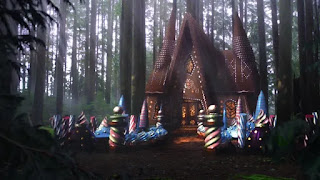Hansel and Gretel, the children’s opera by Engelbert Humperdinck (not the singer, but rather the 19th century composer) has been, for most of a century, a beloved fixture of the holiday season. Unfortunately, the population that enjoyed children’s opera, or even opera of any sort, has been in decline, and the new generation of TV executives is probably unwilling to program anything that couldn’t go head-to-head with the SuperBowl, and so I suspect that Hansel und Gretel will probably only be scheduled at 2:00 AM on a Sunday night. The libretto is by Adelheid Wette, the sister of Engelbert H. (The premiere of the opera was conducted by Richard Strauss, well known as an excellent conductor.)
‘Hansel’ is an abbreviation of Johannes, a common old German name—Mozart’s first name, incidentally—and the el ending of the name is a characteristically South German variant of the diminutive, I’m given to understand.
Likewise, ‘Gretel’ is an Alpine diminutive of Margaret. So that should settle any questions in anyone’s mind about how exotic these names were; this is a story about Peggy and Johnny, the kids next door.
Even though the story (from the Brothers Grimm) is well known all over the world, and certainly in Germany, what is amazing about this opera is the music. Engelbert Humperdinck was a Wagnerian, which means that he had adopted Wagner’s brilliant idea (which Korngold, and John Williams, and other Hollywood composers also used) of referring to various ideas, feelings, and events, with a characteristic, memorable snippet of melody, or harmony, or both, called Leitmotifs.
The Overture is a conventional potpourri overture, which is the most sensible choice for a children’s opera; if kids hear a catchy tune right at the beginning, before any action takes place, they’re likely to remember that tunelet when it makes its formal entrance. (A major problem to be solved for Wagnerian composers is: how to introduce a Leitmotif, and anchor it to the intended idea.) The first tune in the overture is the hymn-like tune to which is sung the Children’s Prayer; a sort of “Now I lay me down to sleep” prayer in sung form. Next is a fierce segment, depicting the Witch. This is the violent aspect of the Witch, in contrast to the sneaky aspect of her!
The Overture does contain fragments of all the important themes, but all adjusted to the needs of the overture, and not letting it degenerate into a mere catalog. The evening prayer is its central melody, and ends up being a sort of anthem for the entire opera. Next in importance is a jolly little tune that represents the playfulness and innocence of the two children. Gretchen teaches her brother a little dance, and sings this little tune with the dance instructions. These two tunes are the poster-boys for the entire opera, though neither of them, in my mind, have much to do with the plot.
The story is more elaborate than the basic one which English-speaking children learn; German versions of the story are typically a lot more elaborate. Germans take their children a lot more seriously, based on their children's literature.
The story begins in the poor home of the children, and for reasons I cannot remember, the two kids find themselves in the woods, and unable to find their way back home. Gretel—the older child, in the story—tries bravely to keep her brother’s mood cheerful (hence the little dance), and presently, they settle down to sleep, because it is getting dark and scary.
While they’re asleep, a whole ballet troupe of angels come and parade around them, to keep them safe through the night. (A ballet sequence is common in most German operas.)
When they wake up in the morning, it becomes clear that the trail that Hansel believes he has laid down, to help them return home, has completely vanished. The children are led further into the forest, until they stumble on the witch’s famous cottage. The cottage, of course, is made of gingerbread and candy, and the hungry kids cannot help themselves, and pick off pieces of it to eat. They hear a raucous voice from inside, calling: “Nibble, nibble mousie, nibbling at my housie!” The kids are momentarily transfixed, and after much clever dialog, find themselves shut away in a little cage.
The rest of the story goes according to the conventional plan with the possible addition of a few hunters. (One is led to speculate that the hunter lobby was strong in those times.) The enormous ballet interlude lengthens the story by almost half an hour. The kids return home, to find that all the financial tribulations have somehow been swept away, which is just as well, because they bring with them a score of formerly ensorcelled young people. (As is well known, the death of a sorcerer releases all his or her spells.)
While Humperdinck was a serious musician, and his adherence to Wagnerian principles was serious, he keeps a careful eye on how palatable the melodies and the harmonies of this work are, to kids and their parents. In the end, his efforts were well rewarded, though whether the man himself was rewarded I do not know; very little of his output is well known today. H and G, though, deserves a century or two more of popularity.
Archie


No comments:
Post a Comment